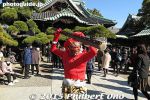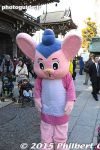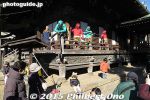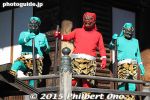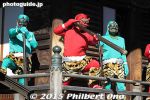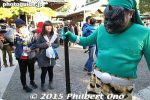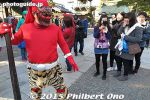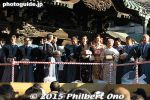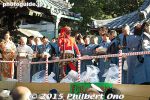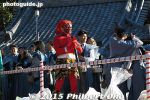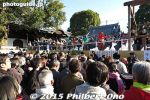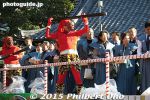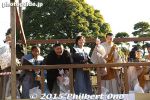 Image search results - "taishakuten" Image search results - "taishakuten" |

Sando worship path to Taishakuten temple. Shibamata is in Tokyo's Katsushika Ward bordered by the Arakawa River in the west and by the Edogawa River in the east.
|
|
|

Sando worship path to Taishakuten temple
|
|

The path is lined with shops.
|
|

The shop sells kusa dango (mugwort dumplings with real grass inside), the local specialty. Photo: Nitenmon Gate in view
|
|

Toward the end of the shop-lined mall, you will see this Nitenmon Gate of the Shibamata Taishakuten Temple, formally known as Daikyoji. 二天門
|
|

Wood carvings on Nitenmon Gate
|
|

This temple serves as a recurrent backdrop in the Tora-san series. The temple's priest is played by the humorous Ryu Chishu who actually came from a family of Buddhist priests. Photo: Bell tower
|
|

The Nitenmon Gate was completed in 1896 and features wooden statues of Zocho and Komoku, two of the four Devas which guard the four cardinal directions from demons.
|
|

Founded in 1629 by a priest named Nitchu and his disciple Nichiei, the temple belongs to the Nichiren sect of Buddhism.
|
|

The present Naiden (Inner Sanctuary) was completed in 1915. Keyaki (zelkova) was used for all the wood in the building. The present Haiden (Worship Hall) was completed in 1929. Photo: Taishaku-do Hall 帝釈堂
|
|

Taishakuten is the god Indra from Brahmanism, a Hindu religion. Being the god of rain and thunder, Indra was a powerful warrior god that was adopted by Buddhism as a protector. Photo: Glass wall protecting the exterior of Taishaku-do Hall.
|
|

It was believed that Indra would step in and chase away the demons causing calamities to the followers of Buddhism. Photo: Wood Carving Gallery (admission charged)
|
|

The side and rear exterior walls of the Taishakudo are blanketed with panels of detailed woodcarvings. They are the most outstanding feature of Shibamata Taishakuten Temple.. 彫刻ギャラリー
|
|

There are ten large carvings (each 2.27 meters by 1.27 meters) depicting scenes from the Lotus Sutra (Hokekyo).
|
|

The woodcarvings were requested by the temple's 16th priest, Nissai. Through a generous donation from devoted follower Suzuki Genjiro, the project was begun.
|
|

The first panel was completed in 1922. The carver, Kato^ Toranosuke, proposed that the remaining 9 panels be carved by renown woodcarvers living in Tokyo. A large keyaki panel was delivered to each of the nine carvers.
|
|

However, in 1923, the Great Kanto Earthquake struck and these panels did not survive. A subsequent search for replacement panels was conducted nationwide.
|
|

In 1926, large keyaki replacement panels were finally procured and the project was back on track. The carvings were completed in 1934.
|
|

Since such large pieces of keyaki wood are very difficult to find and the carvings are so fine, the carvings are regarded as highly valuable cultural assets.
|
|

If you want a detailed explanation (in Japanese) of the Lotus Sutra scenes depicted by the woodcarvings, buy the pamphlet that is sold at the temple's souvenir stand near the Nitenmon Gate.
|
|
|
|
|
|
|
|

To protect the exterior woodcarvings from the elements and to allow visitors to view them up close, the temple built a transparent, permanent scaffolding on the side and rear exterior walls of the Taishakudo.
|
|

It makes you feel like you are in an art gallery. From the front of the Taishakudo, the scaffolding is neatly concealed from view.
|
|
|
|
|
|
|
|
|
|
|
|
|
|
|
|

Since the carved walls are two stories high, the scaffolding has upper and lower levels which allows you to view the woodcarvings on the upper and lower halves of the walls. This is the lower floor
|
|

Dragon
|
|

You can walk down a corridor to the Daikyakuden (Reception Hall) made entirely of hinoki (Japanese cypress). This hall faces the lovely Suikeien Garden.
|
|

Corridor to Guest House (Dai-kyakuden)
|
|

Even the corridor has wood carvings.
|
|

Corridor of guest house 大客殿
|
|

Hina dolls in guest house room 大客殿
|
|

Hina dolls in guest house room 大客殿
|
|

Hinamatsuri dolls 大客殿
|
|

Folding screens
|
|
|
|

Garden hallway 庭園
|
|

Tea ceremony house 茶室
|
|

Suikeien Garden 庭園
|
|
|

Nitenmon Gate as seen from Taishaku-do Hall
|
|
|
|
|
|

Rear of Nitenmon Gate
|
|

Nitenmon Gate carvings
|
|

Nitenmon Gate carvings
|
|

Daishoro (bell tower)
|
|
|

Goshinsui (purification water fountain).
|
|

Goshinsui (purification water fountain).
|
|

Sacred water 御神水
|
|

Minami Daimon Gate 南大門
|
|

Hondo Hall and Shaka-do Hall
|
|

Hondo main hall 本堂
|
|

Map of temple grounds
|
|
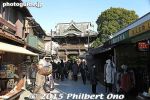
Taishakuten temple holds its annual setsubun bean throwing event on Feb. 3 in the afternoon. In 2015, they threw beans at 2 pm and 3 pm. About 10 min. each time.
|
|
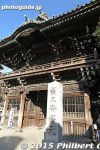
Gate to Taishakuten temple.
|
|
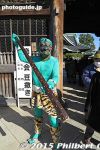
Greeting us is a green ogre.
|
|
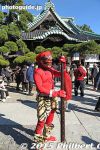
Another oni (ogre).
|
|
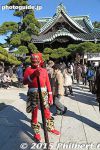
Red orgre (oni) at Taishakuten temple in Shibamata for setsubun on Feb. 3.
|
|
|
|
|

Setsubun bean throwing at 2 pm and 3 pm within the temple grounds.
|
|
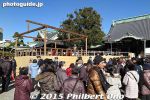
A wooden platform was constructed for the bean throwers. Great weather in 2015.
|
|
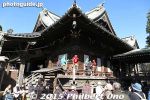
Ogre hanging out at the worship hall. This building has exquisite wood carvings on the exterior walls.
|
|
|
|
|
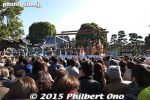
At 2 pm, the bean throwers started throwing the beans.
|
|
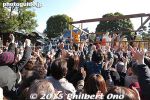
For the bean throwing, they did not allow anything other than your hands to catch the beans. No bags, boxes, umbrellas, etc.
|
|
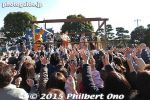
Very civil, no pushing/shoving.
|
|
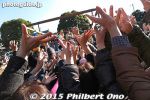
Setsubun bean throwing at Taishakuten temple on Feb. 3.
|
|
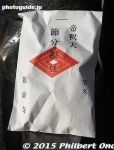
Bagged this bag of beans at Taishakuten.
|
|
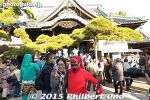
After the first bean throwing session, people wait for the second one to start at 3 pm.
|
|
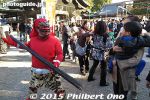
Oni ogres like to pose for photos.
|
|
|
|
|
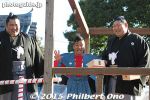
No celebrities except for a few sumo wrestlers.
|
|
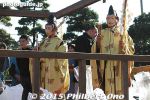
Monkeys are Taishakuten's messengers. They chased out the ogre before they start throwing the beans.
|
|
|
|
|
|
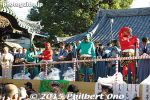
The ogre, representing disease and misfortune, are about to be chased out.
|
|
|
|
|
|
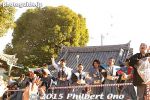
They threw the beans and I put down my camera to catch another bag of beans.
|
|
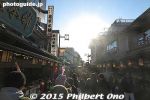
While carrying home my lucky beans, I was convinced that 2015 would be a great year.
|
|
|
|












































































